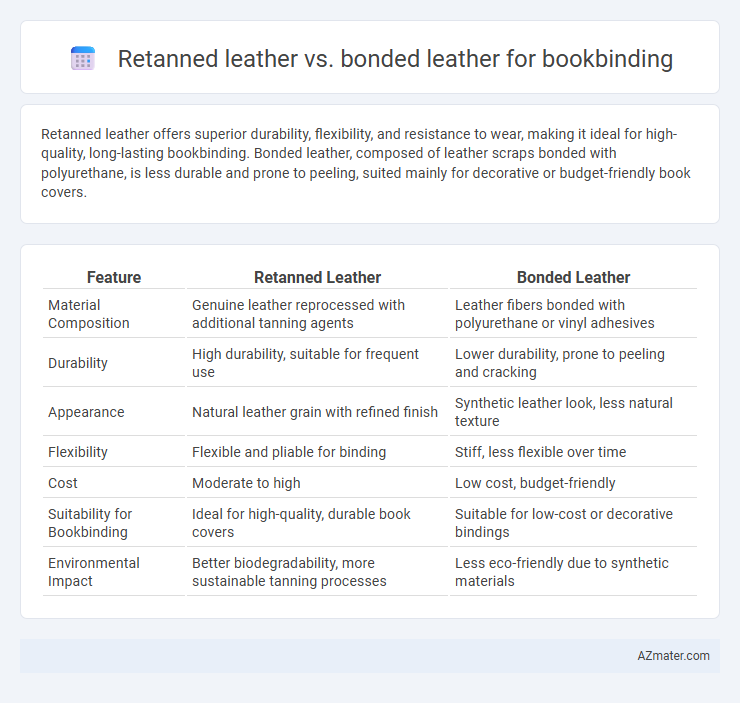Retanned leather offers superior durability, flexibility, and resistance to wear, making it ideal for high-quality, long-lasting bookbinding. Bonded leather, composed of leather scraps bonded with polyurethane, is less durable and prone to peeling, suited mainly for decorative or budget-friendly book covers.
Table of Comparison
| Feature | Retanned Leather | Bonded Leather |
|---|---|---|
| Material Composition | Genuine leather reprocessed with additional tanning agents | Leather fibers bonded with polyurethane or vinyl adhesives |
| Durability | High durability, suitable for frequent use | Lower durability, prone to peeling and cracking |
| Appearance | Natural leather grain with refined finish | Synthetic leather look, less natural texture |
| Flexibility | Flexible and pliable for binding | Stiff, less flexible over time |
| Cost | Moderate to high | Low cost, budget-friendly |
| Suitability for Bookbinding | Ideal for high-quality, durable book covers | Suitable for low-cost or decorative bindings |
| Environmental Impact | Better biodegradability, more sustainable tanning processes | Less eco-friendly due to synthetic materials |
Introduction to Bookbinding Leather Types
Retanned leather offers enhanced durability and flexibility, making it ideal for high-quality bookbinding projects that require longevity and a refined finish. Bonded leather, composed of leather scraps bonded with polyurethane, provides a cost-effective alternative but lacks the resilience and authentic feel of retanned leather. Choosing the right type depends on the desired balance between budget constraints and the need for durability in bookbinding applications.
What is Retanned Leather?
Retanned leather, used in bookbinding, undergoes a secondary tanning process that enhances its durability, suppleness, and resistance to wear compared to standard leather. This process involves re-tanning with various agents like chrome or vegetable extracts, producing a more stable and high-quality material ideal for preserving book longevity. Retanned leather maintains natural grain and texture, offering superior flexibility and a luxurious finish essential for premium book covers.
What is Bonded Leather?
Bonded leather is a material made by blending shredded leather scraps with a polyurethane or latex binder, pressed onto a fiber or paper backing, often used in bookbinding for its cost-effectiveness and uniform appearance. Unlike retanned leather, which undergoes an additional tanning process to enhance durability and flexibility, bonded leather lacks the natural grain and strength of full-hide products. Its limited breathability and lower resistance to wear make bonded leather suitable for decorative book covers rather than long-lasting, high-quality bookbinding applications.
Durability Comparison: Retanned vs Bonded Leather
Retanned leather offers superior durability compared to bonded leather due to its full-grain or top-grain structure, which maintains strength and resistance to wear over time. Bonded leather, made by combining leather scraps with adhesives, tends to degrade faster, showing signs of peeling and cracking under regular use. For bookbinding, retanned leather ensures long-lasting protection and aesthetic appeal, whereas bonded leather is more prone to damage and less suitable for preserving valuable volumes.
Aesthetic Qualities: Texture and Appearance
Retanned leather offers a rich, natural texture with visible grain patterns and a smooth, supple feel that enhances the elegance of bookbinding. Bonded leather, composed of leather scraps bonded with polyurethane, presents a uniform surface but lacks the authentic depth and character found in genuine leather, often showing artificial texture patterns. The aesthetic qualities of retanned leather provide a classic, luxurious appearance that significantly elevates the visual appeal of handbound books.
Flexibility and Handling During Binding
Retanned leather offers superior flexibility and durability, making it ideal for bookbinding as it conforms easily to the book's spine and withstands repeated handling without cracking. Bonded leather, composed of leather scraps bonded with polyurethane, tends to be stiffer and less resilient, often resulting in reduced flexibility that can complicate the binding process and cause early wear. Choosing retanned leather ensures better handling during binding and a longer-lasting, more pliable cover for books.
Longevity and Aging of Book Covers
Retanned leather exhibits superior longevity and natural aging characteristics, developing a rich patina over time that enhances the aesthetic and durability of book covers. Bonded leather, composed of leather scraps bonded with polyurethane or latex, tends to deteriorate faster, often peeling and cracking due to its lower fiber content and reliance on synthetic binders. For bookbinding, retanned leather's resilience and ability to maintain structural integrity make it the preferred choice for long-term preservation and visual appeal.
Environmental Impact and Sustainability
Retanned leather used in bookbinding undergoes a secondary tanning process that enhances durability while reducing chemical waste compared to traditional methods, making it a more sustainable choice. Bonded leather, composed of leather scraps and synthetic materials bonded with polyurethane or latex, often involves environmentally harmful adhesives and shorter lifespan, leading to increased waste. Choosing retanned leather supports eco-friendly practices through resource efficiency and longer product longevity in sustainable bookbinding.
Cost Differences and Value for Money
Retanned leather offers superior durability and a natural texture, making it a premium choice for high-quality bookbinding, albeit at a higher cost compared to bonded leather. Bonded leather, composed of leather scraps bonded with polyurethane or latex, is significantly cheaper but less durable, often showing wear and flaking over time. For bookbinding projects where longevity and appearance are crucial, retanned leather provides better value for money despite the initial investment.
Choosing the Best Leather for Bookbinding
Retanned leather offers superior durability and flexibility, making it ideal for high-quality bookbinding where longevity and aesthetic appeal are priorities. Bonded leather, composed of leather scraps bonded with polyurethane, provides a cost-effective alternative but lacks the resilience and natural texture of retanned leather. For bookbinding applications demanding archival quality and premium finish, retanned leather is the preferred choice, ensuring enhanced structural integrity and a refined appearance.

Infographic: Retanned leather vs Bonded leather for Bookbinding
 azmater.com
azmater.com